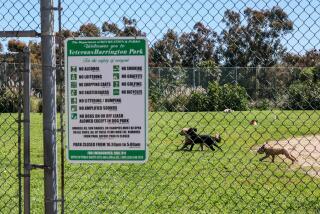Chasing 4-Legged Gang Members
Although stray dogs usually generate sympathy, not fear, animal control officers say they are a growing danger on our streets. The Los Angeles County Department of Animal Services estimates that there are as many as 44,000 stray canines roaming the city of Los Angeles. Homeowners associations citywide are reporting more problems with strays then ever, according to the American Humane Assn.ŌĆÖs Western region bureau. These strays often join packs that may attack adults, children and family pets. Many pet owners who relocate simply abandon manŌĆÖs best friend to run wild. RACHEL FISCHER spoke with an expert from the recently formed Animal Roping for Safety Squad unit of the Los Angeles County Department of Animal Care and Control.
JAIME MERAZ
Captain, Department of Animal Care and Control
*
ItŌĆÖs obvious from the volume of complaints that the problem has worsened over the past five years. The most that we have captured in one day is 122 dogs; the average is 60 to 70, for the whole county. Compton and Los Angeles have the highest concentration of dogs.
The county went through a budget crunch several years back, which didnŌĆÖt allow us enough manpower to take on the task. We have trucks that are our own now, and we sometimes work 10- to 14-hour days. We have 10 people in our unit; before, Animal Control people from various shelters would be called on to help when they could be spared.
We roll out of here at 5 a.m.; thatŌĆÖs when the dogs are out. We start by responding to calls regarding menacing animals. Then we do random sweeps of the different cities we service--42 total--from Whittier to Malibu.
Packs of dogs usually start the day by scrounging through trash, and when people walk by, the dogs think theyŌĆÖre going to take the food away. They become defensive and attack.
When dogs get together with other abandoned dogs, they become territorial. Areas with lots of abandoned buildings are especially vulnerable to these packs, because they make for good hiding places. The packs can run up to 20 dogs. They act like wild animals, even if they are technically domestic canines.
In low-income areas, people often buy guard dogs, so the abandoned dogs will be extremely aggressive breeds such as pit bulls. Believe it or not, though, lately weŌĆÖre seeing Chihuahua packs and even they can be mean when youŌĆÖre trying to rope them.
Sometimes, peopleŌĆÖs house pets will go out to go to the bathroom and join a roving pack of dogs. The dogs are like little gangs of people; once they become two or three or four [in number], they suddenly act brave in defense of the others. A person walking his own dog can sometimes be attacked by a pack. Even if you manage to drag your pet and yourself back into the house, the pack will wait outside, leaving you trapped. ThatŌĆÖs when we get called to the rescue.
WeŌĆÖve rescued people from the tops of cars and fences. We once found a mailman up a tree. The dogs donŌĆÖt just bite once; theyŌĆÖll tear the skin and keep going.
We have a rope of 25 to 30 feet in length and we work in teams. When the animal runs past, we rope him in. Usually, theyŌĆÖll back down at that point, but sometimes a canine will lunge at you.
We canŌĆÖt go out on sweeps every day because the shelters are too full. If we can get these animals into a shelter, theyŌĆÖre usually not in good shape. Besides not looking very good for adoption--generally theyŌĆÖll have distemper and broken legs--theyŌĆÖre too violent to make good pets.
More to Read
Sign up for Essential California
The most important California stories and recommendations in your inbox every morning.
You may occasionally receive promotional content from the Los Angeles Times.










